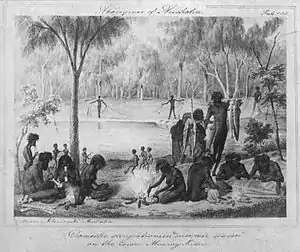Woggabaliri
Woggabaliri is a traditional Indigenous Australian "co-operative kicking volley game".[1]

The Aborigines in areas of and near New South Wales played a ball game called Woggabaliri. The ball was usually made of possum fur, and was played in a group of four to six players in circle. It was a co-operative kicking game to see for how long the ball can be kept in the air before it touches the ground.[2]
History
'Woggabaliri' was documented prior to 1904 as the Ngunnawal word for "play".[3] Played by the Wiradjuri and surrounding peoples before European arrival,[4][5] Woggabaliri is a non-competitive game played with a ball made of Bulrush roots wrapped in possum fur where the objective of it is to keep the ball in the air using association football type skills of teamwork and ball control.[1] Author Ken Edwards notes that a similar game with a ball made of grass covered in beeswax was also played by the Jingili people of the Northern Territory.[5]
Woggabaliri is recognised by the Australian Sports Commission (ASC) as one of the oldest Indigenous ball games and is the earliest depicted, believed by the ASC to be the subject of an engraving "never let the ball hit the ground" based on William Blandowski's observations in 1857 of camp life near Merbein, Victoria.[4] The image is inscribed:
A group of children is playing with a ball. The ball is made out of typha roots (roots of the bulrush). It is not thrown or hit with a bat, but is kicked up in the air with a foot. The aim of the game – never let the ball touch the ground.
In 2010, Football Federation Australia referenced Woggabaliri in its Australian 2022 FIFA World Cup bid citing its similarity to football (soccer) as part of Australia's national heritage.[4]
Modern play
In Australia the Laureus Sport for Good Foundation promotes Woggabaliri as one of several Indigenous games available as an addition to traditional school sports.[6] The New South Wales Department of the Arts, Sport and Recreation promotes Woggabaliri in New South Wales schools.[7][8] Woggabaliri was also included as an activity in Teacherwebs 2010 summer camp schedule in the United States.[9]
Basic rules
The game is played by groups of four to six players standing in a circle 2 metres apart and uses either an association football or a volleyball ball. Using feet and knees only,[10] in no set order but without consecutive touches, the players attempt to keep the ball from touching the ground. The group that has the most touches in a set time wins. If the ball touches the ground the count is restarted.[11][12]
Team rules
Two teams of four play on a volleyball court sized pitch with football (soccer) goals at each end. A game consists of two-halves lasting 10 minutes each. Players may use feet, knees, thighs, chest and head to keep the ball aloft with the team losing possession if the ball touches the ground, is intercepted or an infringement occurs. Tackling is not permitted, and goals can be scored from any part of the pitch.[11][12]
See also
References
- Maynard, John (2011), The Aboriginal soccer tribe : A history of aboriginal involvement with the world game, Magabala Books, ISBN 978-1-921248-39-9
- "Woggabaliri". NSW Government - Office of Sport. Retrieved 4 November 2018.
- R. H. Mathews (1904). "The Wiradyuri and Other Languages of New South Wales". Project Gutenberg.
- Tim Hilferti, The Australian Game The Advertiser p. 79 24 October 2010
- Edwards, Ken (1999). Choopadoo: games from the dreamtime. QUT Publications. ISBN 1-86435-448-8.
- Gorton, Stan (3 January 2002). "Sports legends visit city". Port Lincoln Times. Archived from the original on 2 March 2012.
- "Getting active: Coaching". Healthy Kids website. NSW Government. Archived from the original on 9 July 2009. Retrieved 24 October 2010.
- Bennett, Isabelle (2007). "Traditional Indigenous Games. Cultural renewal and friendship beat winning" (PDF). Sport Shorts. 7 (2): 15.
- CCAP - 2010 Summer with a TWIST! Teacherweb
- Foster, Craig (23 October 2011). "Indigenous Australians put their foot down to fully embrace the world game". The Sydney Morning Herald. Fairfax Media. Retrieved 6 November 2018.
- "Woggabaliri" (PDF). Australian Government, Australian Sports Commission. Retrieved 6 November 2018.
- "Indigenous Traditional Games" (PDF). Australian Sports Commission. 2000. p. 14. Archived from the original (PDF) on 9 May 2009. Retrieved 6 November 2018.